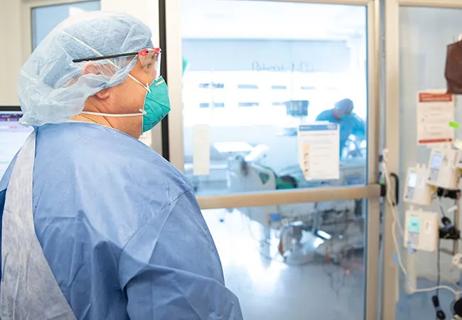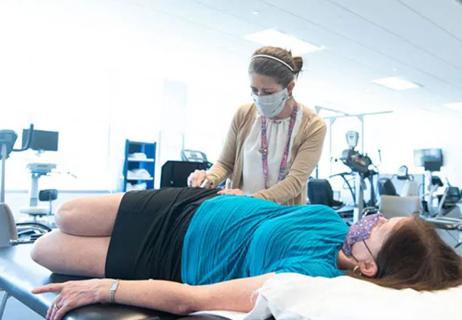Eye-gaze tracking, enzyme replacement therapy, tablet-based data collection

No universal comprehensive standards of care exist for autism. There are likewise no biomarkers or objective methods for tracking treatment progress. At the same time, genetic research into the disorder has exploded in the past decade, with more than 200 genes found to be involved in — and possibly causative of — autism.
Cleveland Clinic is a non-profit academic medical center. Advertising on our site helps support our mission. We do not endorse non-Cleveland Clinic products or services. Policy
For Thomas W. Frazier II, PhD, this mix of knowledge proliferation with the absence of standards makes for a certain creative chaos. “Autism is a ‘Wild West’ right now,” said Dr. Frazier, Director of Cleveland Clinic Children’s Hospital Center for Autism.
He made that observation in an expert panel discussion, “Autism: The Next Generation,” that he moderated at Cleveland Clinic’s neuroscience-focused 13th Annual Medical Innovation Summit in late 2015. The session showcased several intriguing advancements in the identification and treatment of patients with autistic disorders, three of which are profiled here.
Dr. Frazier is currently conducting clinical studies in support of a device that uses remote eye-gaze tracking to generate an autism risk index. The first of those studies, published in April 2016, showed the resulting autism risk index to have high diagnostic accuracy, suggesting that the device might ultimately help identify children with autism earlier and more objectively — as well as track treatment progress.
“Right now we rely on subjective measurements, like clinician observation and parent reports,” said Dr. Frazier. “Because of that, we miss some kids. Having a quantitative measure of autism symptoms could substantially increase the accuracy of clinical diagnosis and help raise parents’ confidence in diagnoses.”
RELATED: Eye-Gaze Tracking: The First Objective Diagnostic Tool for Autism?
On the treatment front, Dr. Frazier noted that only two medications are FDA-approved for irritability associated with autism, and none are approved for treating core symptoms of autism. This dearth of therapies spurred research and development that set the stage for a large ongoing clinical trial to test the first drug designed specifically to treat core symptoms of autism.
The trial’s roots reach back to observations by Dr. Frazier’s summit co-panelist Joan Fallon, DC, founder and CEO of Rye, New York-based biopharmaceutical company Curemark, when she was investigating GI-related conditions as a practicing pediatric clinician more than a decade ago.
Mindful that GI conditions are among the leading comorbidities impacting the lives of individuals with autism, Dr. Fallon noticed from stool samples that many children with autism did not properly digest protein. An enzyme biomarker of this inability was identified, and a study of children at various points along the autism spectrum showed that over 60 percent of them had the biomarker. “This was the first big, unified evidence of a physiological finding,” Dr. Fallon explained.
The finding prompted her to form Curemark, which developed CM-AT, a protease-based compound designed to enhance protein digestion. The concept behind the approach — termed enzyme replacement therapy (ERT) — is to restore the pool of essential amino acids in children with autism who exhibit impaired protein digestion, with the theoretical effect of more effective brain signaling.
This ERT approach is being evaluated in a randomized, placebo-controlled phase 3 trial of CM-AT for the treatment of core symptoms of autism in children with all levels of fecal chymotrypsin. Initial results are promising, noted Dr. Fallon. Full enrollment in the study, in which Cleveland Clinic and Dr. Frazier are participating, is expected by December 2017.
Dr. Fallon expects more targeted treatments to become available over the next decade. “Genetic work is going to bring us a lot closer to more personalized treatments for children with autism,” she said.
Just as autism biomarkers have been elusive, so have large-scale digital data repositories on the condition. Typically, data have been recorded by hand and stored on paper, making large-scale generation of accurate profiles of individuals with autism difficult. But new tablet-based data-collection software aims to overcome this barrier by streamlining workflow for therapists.
Developed by ABPathfinder in Overland Park, Kansas, the new software is intended as a building block for a data repository over which research models can be imposed, said summit panelist Jeff Blackwood, CEO and President of ABPathfinder (now Pathfinder Health Innovations).
The company’s database included some 3,300 children with autism as of autumn 2015. Though that number is growing fast, other neuropsychiatric diseases typically have 50,000 to 100,000 records, noted Blackwood. “Autism is in its infancy with regard to data-gathering,” he said.
The software aims to opens the door to personalized treatment, according to Blackwood. For example, therapists can use the software to collect data from a device, such as a digital watch fitted with an accelerometer, to measure when and how often a child is “stimming,” or exhibiting self-stimulatory, repetitive behaviors.
Blackwood described the software as a “blank-slate platform” with applied behavior analysis at its heart. “Data-collection approaches like these are a building block that’s going to help move autism research forward significantly in the next few years,” he said.
While these and other autism advancements share a vital emphasis on early identification and intervention, Dr. Frazier concluded the session with a bigger-picture observation.
“Early intensive behavioral intervention is very effective for maximizing outcomes,” he said, “but most people with autism continue to have difficulties throughout their lives. Even high-functioning people can have trouble holding a job as they get older. Teaching certain aspects of social behavior can be really effective in helping patients function, but that doesn’t take away their autism.”
He sees a societal evolution underway to offer better support for high-functioning adults with autism, citing a growing willingness of businesses to adapt jobs to accommodate such individuals. “Our society is starting to adapt to the presence of people who are not very good socially and who need those supports,” he said. “That’s a huge positive.”
A video of the panel discussion and other 2015 Medical Innovation Summit sessions is available here (select “Videos” tab and Video 44).

Q&A with Brain Trauma Foundation guideline architect Gregory Hawryluk, MD, PhD

Q&A with newly arrived autoimmune neurology specialist Amy Kunchok, MD

A neurocritical care specialist shares what’s spurring growth of this new evaluation approach

Focused ultrasound offers a newer alternative to deep brain stimulation

Prehabilitation can help improve outcomes after spine surgery

Get ready for central vein sign and optical coherence tomography

How these new drugs fit into practice two years out from their first approvals

A conversation on the state of physiatry with the AAPM&R’s Vice President